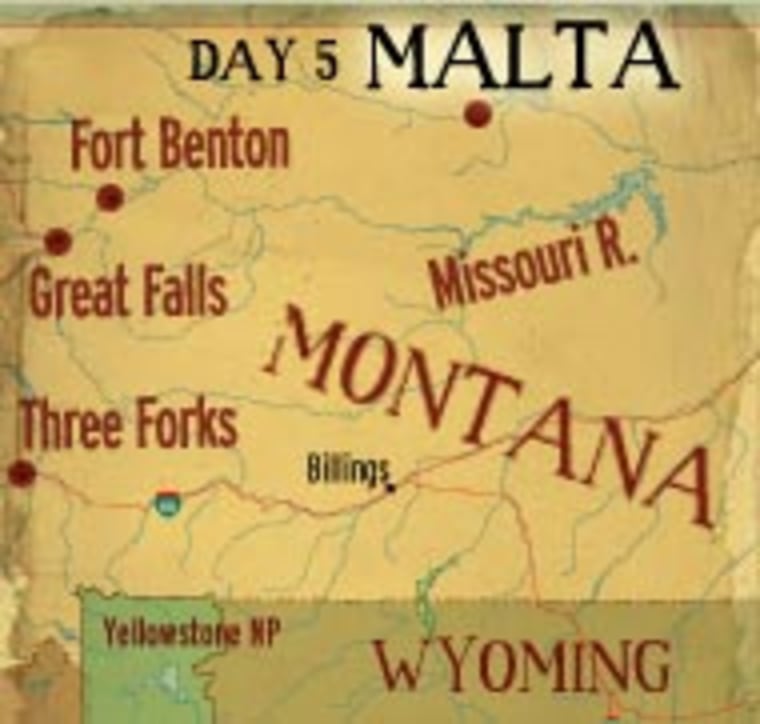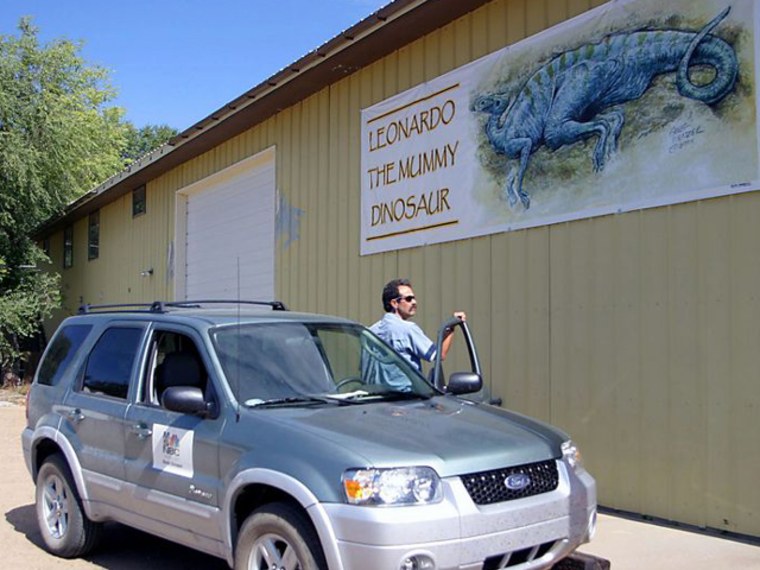On the south side of Highway 2 in Malta, there is a converted tire shop where the past is being unearthed. It is the Dinosaur Field Station, headquarters to the Judith River Dinosaur Institute, brainchild of “the people’s paleontologist,” Nate Murphy.
Nate never got his doctorate — nor his masters, nor bachelors degree, probably in part because he has severe dyslexia. Naturally, some overly-degreed academics in the field look down noses at the un-doctor. But he’s been a fossil hound since he was 10, and he’s made some impressive and important finds. Now 47, he is the most unabashedly enthusiastic evangelist for the art and science of paleontology on, or below, this earth.
We meet him in the bar of the Great Northern Hotel in Malta. The railroad inn is really little more than a motel, but it does have the first high-speed wireless connectivity we’ve encountered on this trip, due, we’re told, to the number of finely funded dino-diggers who come to town. Before the first beer Nate produces a long black serrated scimitar-shaped something, which looks like a potato peeler.

It’s a T-Rex tooth, he informs us, one of 60 in a typical set. Nate reports that a full grown Tyrannosaurus could swallow 150 pounds of flesh in a bite. It turns out Speilberg’s Jurassic renderings were pretty close to reality, according to Nate, with one huge error. “Remember when the T-Rex , the greatest predator that ever lived, chomps the lawyer in two? Would never happen. Professional courtesy.”
I ask the adolescent question that piques most Michael Crichton readers: Could we actually extract dinosaur DNA, like in the book, and bring them back? “Well, imagine a spiral staircase 100,000 miles high, and we’re missing 80,000 miles worth. It ain’t gonna happen while we’re around,” Nate twinkles.
In good company
Thomas Jefferson was also an avid paleontologist without formal training, and when he gave his instructions to Lewis and Clark in 1804 to explore the Missouri, he specifically asked they look for and bring back fossils. In the spring of 1805 they passed a tributary river Clark named Judith, after a young woman he fancied back home. (She happened to be his cousin and later became Mrs. Clark.)
Lewis and Clark never ventured up the turgid stream, thereby missing one of the finest dinosaur fossil beds in the world. It’s here that in 2000 Nate Murphy found Leonardo, a 77-million-year-old mummified brachylophosaurus (duck-bill), since entered into the Guinness Book of World Records as the “best preserved dinosaur” specimen discovered to date.
The next morning we take the block-long trek to Nate’s Dinosaur Field Station, where he and his volunteer assistant Rhonda Suggs work to clean, prepare and place pieces in giant fossil jigsaw puzzles. First he shows off Roberta, a perfectly articulated duck-bill he found here in Phillips Country two years ago.

The key to being a good fossil, Nate shares, is being buried quickly in the right position in the right environment, such as a creature who stumbles in a tar-pit. Most animals when felled are either picked apart by scavengers, or cleaved and bleached away by weather and erosion, so that when unearthed after a 100 million years or so there are but pieces of the whole. “To find one articulated specimen in an entire career is like hitting the Powerball, it's the jackpot,” Nate says. “One tenth of 1% of all dinosaurs discovered are well-articulated,” meaning all the bones and pieces are intact and in place. “And I’ve found five,” he boasts.
Up close and personal
Nate gives us a tour of Roberta, pointing out her stomach: Her last meal consisted of ferns, conifers, magnolia and 36 other species of plants. “The brachylophosaurus was the ultimate Cretaceous Cuisinart, a Cretaceous cow, so to speak.” Then he moves on to point out Roberta’s broken bill, and pronounces the likely cause of death as starvation.
“How do you know the sex?” I ask, wondering why his finds have names of both genders.
“Must be a male,” Rhonda calls from across the room. “Brain the size of a peanut.”
“It’s still a mystery,” Nate gives the more scholarly answer. “We just name the fossils for the inspiration at the moment, male or female.”
We spend a couple hours wandering around the rooms crammed with 500 specimens, listening to tapes of imagined dinosaur sounds, gawking at bones and dinosaur eggs, and trying to imagine the arc of time represented. One fossil, that of a 30-foot long marine crocodile (Terminonaris cretaceous) is only 110 million years old. Ralph, a new species of long-necked sauropod, hails from the Jurassic period, 150 million years ago or more.
One set of bones, that of a sub-adult hadrasaur, has a big chunk missing from his pelvis. “What happened here?” I ask.
“Attacked by a T-Rex,” Nate chimes back with merry eyes. “Probably tasted like chicken.”
At the end of the tour, he allows us to step into his Negative Air Chamber (basically a room hooked to a vacuum cleaner that sucks out the dust) and view up close and personal the “Rosetta Stone of paleontology”: Leonardo. The 22-foot long duck-bill is in perfect shape. He’s all there, and looks as though he’s about to get up from a nap and skitter away.
Leonardo is the prime draw at the field station, and the viewing and educational fees are the major source of income that keeps Nate’s work going. Since he doesn’t have a Ph.D., Nate can’t qualify for academic or public funding, he can’t dig on public lands, and he has to make deals with private landowners when out hunting bones. But it’s almost as though a lifetime of studying extinct species has given him a special perspective on his own place in the cosmology of bone collectors.
He tells us 99.9% of all things that ever lived on this earth are now extinct. “It’s a natural thing, extinction.” So the academic shrugs and slights in this blink of time don’t seem to matter. He’s happy to keep on digging, pursuing his boyhood passion along a meandering tributary of the Missouri.
As we step out into the sunlight of the present, Nate Murphy throws on his brimmed explorer’s hat, hops into a truck with the license plate “Boneman,” and heads off towards the field, for another dig.
The Great Escapes media team is traveling the length of the Missouri River in September, filing daily dispatches along the way. If you have a question or comment, mail us at greatescapes@msnbc.com.